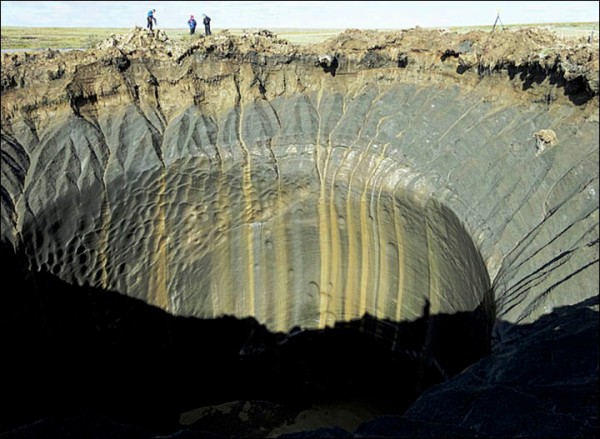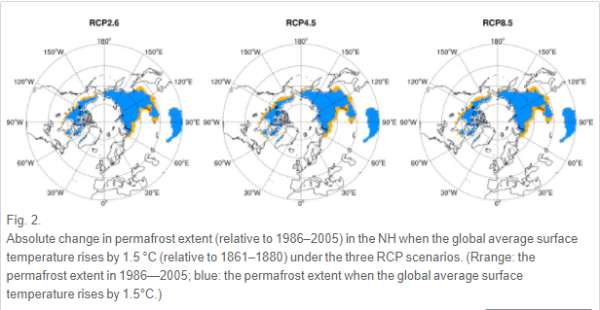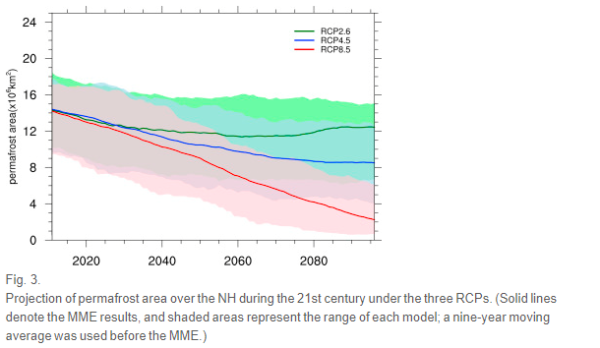More Fire and Anthrax for the Arctic: Study Finds 21 to 25 Percent of Northern Permafrost Will Thaw at Just 1.5 C of Warming
In the far north, the land is rippling, trembling, subsiding, and blowing up as greenhouse gasses are released from thawing frozen soil. Meanwhile, old diseases are being released from thawing carcasses and presenting a health hazard to locals. Strange processes that are likely to accelerate soon as global warming approaches 1.5 degrees Celsius and between 21 and 25.5 percent of all the vast region of Northern Permafrost thaws out.
(More methane blowholes like this one in Yamal are likely as permafrost thaw accelerates in the coming years and pockets of methane explosively remove the land above. How extensive permafrost thaw becomes is directly dependent on how much fossil fuel human societies decide to burn. Image source: The Siberian Times.)
Arctic Carbon Feedbacks Accelerating
Carbon feedbacks from the thawing permafrost are a serious concern. And they should be. There’s about 1,400 billion tons of carbon locked away in that massive region of frozen ground. More than twice the amount humans have already emitted into the atmosphere. And though frozen permafrost carbon stays locked away, thawed permafrost carbon tends to become biologically active — releasing into soils, the water and the air.
Already, this thawing has generated a worrying effect. During the 20th Century, it was estimated that about 500,000 tons of methane were released from the Siberian land-based permafrost region. By 2003, as this permafrost zone warmed, the annual rate of release was estimated to be 3.8 million tons per year. And by 2013, with still greater warming, the rate of release had grown to 17 million tons per year. This compares to a global emission of methane from all sources — both human and Earth System-based — of about 500 million tons per year.
(Megaslump craters like the one at Batagaika, formed by subsidence, are also a result of permafrost thaw. Such features are likely to grow and proliferate as the Earth warms and permafrost thaw expands.)
That’s a thirty-fold acceleration in the rate of Siberian permafrost methane emission over a little more than one generation. One that occurred as temperatures rose to about 1 C above 1880s averages and into a range not seen for about 150,000 years. It’s a warming that has produced visible and concerning geophysical changes throughout the Arctic permafrost environment. In Siberia, lands are subsiding even as more and more methane and carbon dioxide are leeching out. And in the Yamal region of Arctic Russia, temperatures warming into the upper 80s (30 C+) during summer appear to have set off a rash of methane eruptions from the soil even as ancient reindeer carcasses release anthrax spores into the environment as they thaw. From a report this week in The Guardian:
Long dormant spores of the highly infectious anthrax bacteria frozen in the carcass of an infected reindeer rejuvenated themselves and infected herds of reindeer and eventually local people. More recently, a huge explosion was heard in June in the Yamal Peninsula. Reindeer herders camped nearby saw flames shooting up with pillars of smoke and found a large crater left in the ground. Melting permafrost was again suspected, thawing out dead vegetation and erupting in a blowout of highly flammable methane gas.
21 to 25.5 Percent of Northern Permafrost Set to Thaw over Next Two Decades
In total, 14 methane blow out craters are now identified throughout the Yamal region. A testament to the growing carbon feedback coming from previously frozen and inactive stores.
(Permafrost losses are likely to be quite considerable over the coming decades — which is likely to produce serious knock-on effects for local and global environments. But continued fossil fuel burning through end Century produces more catastrophic results. Image source: Responses and changes in the permafrost and snow water equivalent in the Northern Hemisphere under a scenario of 1.5 C warming.)
But, unfortunately, these kinds of weird, disturbing, and often dangerous changes to northern environments are just a foreshadowing of more to come. For a recent scientific study has found that just 1.5 degrees Celsius worth of warming will force between 21 and 25.5 percent of the northern permafrost to thaw. A process that is already underway, but that will continue to accelerate with each 0.1 degree Celsius of additional warming. The study found that the faster human atmospheric greenhouse gas emissions build up, the more rapidly permafrost would thaw once the 1.5 C threshold was reached. Under a rapid human reduction of greenhouse gasses (RCP 2.6 scenario), permafrost thaw was reduced to 21 percent in the study. But under worst case human fossil fuel emissions (RCP 8.5 scenario), the accelerated rate of warming resulted in 25.5 percent permafrost thaw.
Perhaps more concerning was the fact that the study found that this 1.5 C temperature threshold was reached by as early as 2023 under the worst case fossil fuel burning scenario even as it was held off only to 2027 if rapid fossil fuel burning reductions were achieved. A broader sampling of studies and natural variability hold out some hope that 1.5 C might be pushed back to the early to mid 2030s in the absolute best case. However, considering the amount of human emissions already released and in the pipeline even under the best cases, it appears that crossing the 1.5 C threshold sometime in the near future is unavoidable at this time (barring some unforeseen massive global response and mobilization).
(Permafrost losses under different human emissions scenarios through 2100 show that continued fossil fuel burning results in between 47 and 87 percent loss of permafrost area by 2100 [RCP 4.5 and 8.5]. Image source: Responses and changes in the permafrost and snow water equivalent in the Northern Hemisphere under a scenario of 1.5 C warming.)
Overall, the study found that surface permafrost losses lagged the crossing of the 1.5 C threshold by only about 10 years. And that the lowest emissions scenarios (RCP 2.6) resulted in a leveling off of permafrost losses to 24 percent by 2100. Meanwhile, the worst case human greenhouse gas emissions scenarios (RCP 8.5) resulted in 87 percent permafrost area reductions by 2100.
Risk of Serious Carbon Feedback Far Worse With Fossil Fuel Burning
With so much carbon locked away in permafrost, heightened rates of thaw present a risk that longer term warming might eventually run away as millions and billions of tons of carbon are ultimately liberated. Under moderate to worst case human fossil fuel burning scenarios, it is estimated that permafrost carbon emissions could approach 1 billion tons per year or more. At about 10 percent or more of the present human emission, such a rate of release to the atmosphere is about equivalent to that achieved during the last hyper-thermal event of 55 million years ago (the PETM). Moreover, a heightened response by large methane stores could result in a more immediate warming effect as methane is 28 to 36 times more potent a heat trapping gas than carbon dioxide over Century time scales.
A risk of serious carbon feedbacks that accelerate rates of warming this Century and over the longer term is not inconsiderable even with a 24 percent loss of Permafrost under the best case scenario identified by this study. However, the likelihood of a much more serious feedback under continued fossil fuel burning is far more apparent.
(UPDATED)
Links:
Hat tip to Spike
Share this:
Posted in CLIMATE CHANGE






Geen opmerkingen:
Een reactie posten